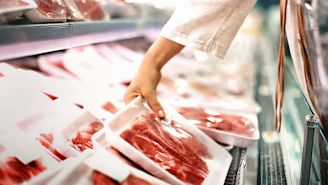How much caffeine is too much?
You may be drinking more than you think—and it could affect your health.
Updated on July 21, 2025

About 85 percent of adults in the United States consume caffeine every day, mostly in the form of caffeinated coffee and tea. Some studies show that regular, moderate coffee consumption could help protect against stroke and dying from heart disease. But having too much caffeine can also lead to health issues.
Learn how much caffeine you may be consuming in beverages, foods, and medications, plus ways to get more energy, naturally.
Correction: A previous version of this slideshow stated that caffeine could help increase the effectiveness of aspirin and acetaminophen by 40 percent. It was updated in July 2025 to correct the overstatement and indicate it may increase effectiveness up to 40 percent.

How caffeine affects the body
Caffeine can be found in many plants, including tea leaves and coffee beans. It’s also found in cacao, used to make chocolate, and kola nuts, used to flavor soda. Man-made caffeine may also be added to certain foods, drinks, and medications.
The substance works to stimulate the central nervous system, which includes your brain, spinal cord, and other nerves. Generally speaking, caffeine makes you feel alert and energized, helping to stave off drowsiness. But it can also have other, less desirable side effects, depending on your age, sex, the medications you take, and your genetics.

Health risks of too much caffeine
The U.S. Food & Drug Administration (FDA) says that up to 400 milligrams of caffeine daily is not normally linked to dangerous or negative effects for healthy adults. But getting too much caffeine can lead to a range of issues, including anxiety, insomnia, a rapid heartbeat, uneven heart rhythm, headaches, dizziness, and dehydration. For people who are more sensitive to caffeine, less than 400 milligrams may also bring about these symptoms.
If you mix caffeine with other substances, it can cause high blood pressure and even a heart attack, says Stefania Koziol, RD, a dietitian in Denver, Colorado. And if you consume caffeine with alcohol (like a rum and Coke), you may feel more alert, which can cause you to drink even more. This combination can lead to intoxication.
If you’re pregnant, stick to 200 milligrams or less a day.

How much is in your beverage of choice?
Koziol says it’s all about moderation: barring a medical condition that would prevent you from drinking any caffeine, it’s usually safe when you stick to recommended amounts. If you’re drinking a variety of caffeinated beverages, you’ll need to keep track of the total amount. Here’s a breakdown of the amount in common caffeinated beverages:
- Teas: 40 to 120 mg per 8 ounces
- Coffee: 102 to 200 mg per 8 ounces
- Decaffeinated coffee: 5 mg per 8 ounces
- Espresso: 30 to 90 mg per ounce
- Regular and Diet Coke: 35 to 47 mg per 12 ounces
- Regular and Diet Mountain Dew: 54 mg per 12 ounces
- Regular and Sugar-Free Red Bull: 80 mg per 8.4 ounces
- 5-Hour Energy: 215 mg per two ounces

There’s caffeine in certain foods, too
You might know that chocolate contains caffeine. But you may not think about how much caffeine is in other foods, like granola bars, yogurt, breakfast cereals, and pudding.
Koziol says to look for coffee or words like “mocha,” “java,” or “energy bar” on food labels. “A lot of frozen coffee-flavored yogurts, granola bars, ice creams, and energy waters and gels have caffeine in them,” she says. You could easily consume caffeine before bedtime without knowing it.
While these foods alone probably aren’t going to cause health issues, if you’re eating them along with drinking caffeinated beverages, you may exceed 400 milligrams per day.

Medications with stimulants
You might be getting small amounts of caffeine in some of your medications, too. Some medications used for premenstrual syndrome (PMS) have up to 60 milligrams of caffeine. That’s because caffeine is considered a diuretic, which causes you to urinate and can help reduce bloating. And since research suggests that caffeine can help increase the effectiveness of aspirin and acetaminophen up to 40 percent, caffeine is used in many common headache drugs.

So, are you addicted to caffeine?
Without knowing it, you can build up a tolerance or addiction to caffeine. “It can create a vicious cycle,” says Koziol. “You’re not sleeping so you’re tired, then the next day you have more caffeine.” One way to know if you’re truly addicted is if you’ve tried to stop drinking caffeinated beverages but can’t.
If you want to nix caffeine from your diet, don’t go cold turkey. Doing so could cause fatigue, depression, lack of focus, and headaches—all signs of caffeine withdrawal syndrome. Withdrawal symptoms can last two to nine days after the last time you’ve consumed it.
Instead, gradually cut back on the amount you drink. Start substituting water or decaf options for some of your caffeinated beverages. If you often drink coffee or tea, one way to wean yourself off it is to mix half decaf and half regular for a while before going completely decaf.

Natural ways to get more energy
Here are ways to boost your energy without drinking a double latte:
Exercise. “You may think that you’re going to feel tired after exercising, but it actually energizes you,” says Koziol. Healthy adults should get at least 150 minutes of moderate-intensity aerobic exercise like walking each week, or 75 minutes of high-intensity aerobic exercise like running or swimming, according to experts. In addition to boosting your energy levels, regular exercise can improve your mood, lower your risk of heart disease, help you maintain a healthy weight, and help you get better sleep.
Drink more water. Koziol says being dehydrated can make you feel tired, too—and drinking too much caffeine can contribute to dehydration. Try to drink a large glass of H20 with every meal. If you don’t have any medical conditions that require you to restrict fluids, shoot for about 11.5 cups of of fluids per day for women and 15.5 for men, reports the U.S. National Academies of Sciences, Engineering, and Medicine. That includes fluids naturally found in foods, as well.
Limit your intake of carbs. Simple carbs like breads, white rice, pasta, and chips can make you feel sleepy. “You want to avoid foods like these that cause your energy levels to spike and then cause a lull afterwards,” says Koziol. Try complex carbs instead: whole wheat breads, brown rice, quinoa, and whole wheat pasta are energy-saving choices.

Walter K. Caffeine and Health. JAMA. 2022 Feb 15;327(7):693.
Sara Berg. What doctors wish patients knew about the impact of caffeine. American Medical Association. January 5, 2024.
U.S. Food & Drug Administration. Spilling the Beans: How Much Caffeine is Too Much? August 28, 2024.
Zhang Y, Yang H, et al. Consumption of coffee and tea and risk of developing stroke, dementia, and poststroke dementia: A cohort study in the UK Biobank. PLoS Med. 2021 Nov 16;18(11):e1003830.
Wang X, Ma H, et al. Coffee drinking timing and mortality in US adults. Eur Heart J. 2025 Feb 21;46(8):749-759.
MedlinePlus. Caffeine. September 8, 2021.
Nemours Kids Health. Caffeine. May 2022.
Centers for Disease Control and Prevention. Alcohol Use: Effects of Mixing Alcohol and Caffeine. May 15, 2024.
American College of Obstetricians and Gynecologists. How much coffee can I drink while I'm pregnant? October 2020.
University of Utah Department of Mathematics. Caffeine Content of Popular Drinks. Accessed July 21, 2025.
Harvard TH Chan School of Public Health. The Nutrition Source: Caffeine. July 2020.
Government of Canada: Health Canada. Caffeine in Foods. April 2, 2025.
Drugs.com. Caffeine. June 20, 2025.
Drugs.com. Does caffeine help migraines? April 10, 2025.
Cleveland Clinic. How To Quit Caffeine Without a Headache. November 10, 2023.
U.S. Department of Health and Human Services. Physical Activity Guidelines for Americans: 2nd Edition. December 2020.
Mayo Clinic. Exercise: 7 benefits of regular physical activity. August 26, 2023.
Mayo Clinic. Water: How much should you drink every day? October 12, 2022.
More On


video

article

slideshow


video


video
